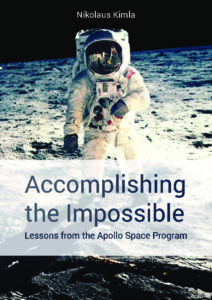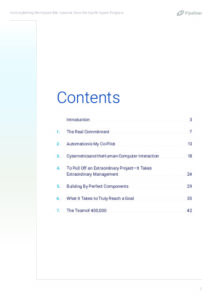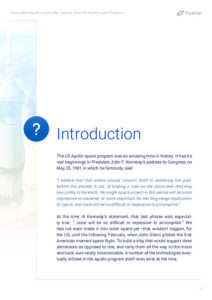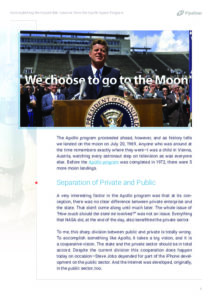The US Apollo space program was an amazing time in history. It had its real beginnings in President John F. Kennedy’s address to Congress on May 25, 1961, in which he famously said:
I believe that this nation should commit itself to achieving the goal, before this decade is out, of landing a man on the moon and returning him safely to the earth. No single space project in this period will be more impressive to mankind, or more important for the long-range exploration of space; and none will be so difficult or expensive to accomplish.”
The Apollo program proceeded ahead, and as history tells we landed on the moon on July 20, 1969. Anyone who was around at the time remembers exactly where they were—I was a child in Vienna, Austria, watching every astronaut step on television as was everyone else. Before the Apollo program was completed in 1972, there were 5 more moon landings.
It is time once again to make big visions, Apollo-sized visions, the fashion once more. Let’s bring the world back to doing great things, instead of app-sized flash-in-the-pan here-today-gone-tomorrow accomplishments.
In this ebook we’ll examine what it really takes to accomplish things of that scope, and why it is more important than ever to do so.
Chapter 1: The Real Commitment
What’s the major problem with a project the size of the Apollo program? It doesn’t come ready made out of a box. There’s not even any books on building one. Nobody knows what it’s supposed to look like.
Chapter 2: Automation is My Co-Pilot
Along with other history-making factors, the Apollo program, thanks to a person almost never mentioned in the news and history of the time, set the stage for the symbiosis between human and machine. It also set the stage for the software industry.
Chapter 3: Cybernetics and the Human-Computer Interaction
In parallel with the Apollo program in the 1960s and into the 1970s, research was occurring at MIT and elsewhere into the blooming science of cybernetics. The originator of the science of cybernetics was American mathematician and philosopher Norbert Wiener. In 1948 he defined cybernetics as “the scientific study of control and communication in the animal and the machine.” Cybernetic pioneer W. Ross Ashby also referred to cybernetics as the “science of simplification.”
Chapter 4: To Pull Off an Extraordinary Project—It Takes Extraordinary Management
Think for a moment what it must have taken to manage a project the size of Apollo, with 400,000 people. Aside from that sheer number, these people weren’t all located in the same room. Or even the same building. Or even the same city. Or even the same state.
Chapter 5: Building By Perfect Components
Building anything well takes time, perseverance, detailed planning and trials. It doesn’t happen overnight. As we saw with the Apollo program, it was built step-by-step, layer by layer.
Chapter 6: What It Takes to Truly Reach a Goal
Only a month after he walked on the moon, Neil Armstrong said, “I felt a successful lunar landing might inspire men around the world to believe that impossible goals really are possible, that there really is hope for solutions to humanity’s problems.” (LIFE magazine interview, August 8th, 1969).
But reaching any goal requires 4 prime factors: time, energy, resources and money. The bigger the goal, the more of each of these things that you need.



































Comments (10)
This has truly inspired me that Pipeliner CRM is possible on a large scale to big companies and multinationals in a CRM near virgin land like Nigeria. Thank you for this Nikolaus
Looking at the concluding statement of Nikolaus Kimla was “… concentrate on the building of a future where we can all not only survive but thrive on this small planet we call home”, Pipeliner CRM and the philosophy on which it is founded is centered on building a better world by using the right mix of time, energy, resources, and money.
Accomplishing the Impossible: Lessons from the Apollo Program has a lot of lesson for leaders in all spheres of life. I would recommend that all visionaries who believe in “long term” endeavors should read this.
I am also glad and privileged to be apart of this “great vision” at Pipeliner CRM.
Extraordinary writeup.Big dreams in the making.
This is such an insightful story. The lessons from it can be easily applied to any project. I have learnt a lot from it and I intend to put all these steps into practice henceforth. The point that post most to me is “to pull an extraordinary project, it takes extraordinary management”. Nothing great comes easy.
This made me to understand the four factors to get to a goal which are time, energy, resources and money . And the most important factor there is time, it doesn’t matter how many times You tried you need perseverance, detailed planning and trials because success can’t be achieve overnight. Thanks Nikolaus for this write-up.
I really think and appreciate the analysis by the writer on how to examine what it really takes to accomplish things of that scope, and why it is more important than ever to do so.
A great and indept analysis in relation to sales achievement and closing.
This story is truly inspiring and can be applied in all human endeavour. To build anything well requires patience, perseverance and proper planning.
What really struck me is the fact that big visions and projects require others to accomplish it, you can do an Apollo size project alone.
What an insight!
This story is truly inspiring and can be applied in all human endeavour. To build anything well requires patience, perseverance and proper planning.
What really struck me is the fact that big visions and projects require others to accomplish it, you cannot do an Apollo size project alone.
What an insight!
I find the 6 strategies analyzed interesting and I keep coming back to read it. I have decided to share with my prospects
This story is truly inspiring and can be applied in all human endeavour. To build anything well requires patience, perseverance and proper planning.
What really struck me is the fact that big visions and projects require others to accomplish it, you can do an Apollo size project alone.
Great article!